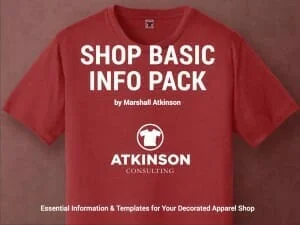How is your shop doing these days?
Is it a rocket ship zipping along at a million miles an hour with everything working perfectly like you have envisioned? Maybe, it’s a daily struggle to avoid the death spiral of black doom that seems to be on the horizon?
Somewhere in the middle perhaps?
One thing is for sure, is that there needs to be some change. In the decorated apparel industry, change is a constant.
New pressures from the competition. Complete business focus and redesign. New technologies and decoration methods. Sales and marketing challenges that you’ve never experienced before. Suppliers that come out with new products and gizmos that will make work easier or more efficient. But you still need to use them.
If you are standing still you are going to be left behind.
But getting everyone in the shop to adopt the new way of thinking or buy into the program is often extremely difficult.
The best way to start that process is by painting a picture of what success looks like. Give everyone that vision of what needs to happen.
What you need, more than anything, is to apply “The Mt. Everest Story” to your shop.
The Mt. Everest Story
I’m not sure where I heard this, but I’ve been telling this story for years.
Where it works best is when you need to get a group of people together to rally behind a common cause.
The story of climbing a mountain is something that everyone can relate to, even though nobody you personally know has accomplished this miraculous feat. It’s an easy mental link to the new idea that you want to roll out.
You are defining the end goal, and what it takes to accomplish the journey.
So let’s say that you want to start a sustainability program, learn four-color process printing, add embroidery to your decoration line up, increase sales by 47%, reduce your set up times to under five minutes per screen, or starting your own retail clothing line.
It doesn’t really matter what you are doing. Your business is your business.
What matters is how you are framing that success story so that your staff will buy into whatever needs to be accomplished.
We do that by framing that new adventure with the metaphor of climbing Mt. Everest.
Learn Your Version of This Story
Here’s what you say:
“Today I want to talk to you about climbing a mountain. Not just any mountain.
It’s Mt. Everest.
At 29,029 ft, it is the highest mountain in the world. Reaching the summit means that we will be walking at the same altitude that airplanes fly.
Can you picture it in your mind?
Majestically tall.
Remote. As it sits between China and Nepal.
Over the years, plenty of people have climbed Mt. Everest successfully. Some climbers have perished in the attempt. Even a limited few have reached the peak multiple times.
It can be done.
But before we can claim victory, we have to start.
Just getting to the valley below the mountain is a journey. Which is where we are right now with the company’s decision to (insert your big goal here).
As a group, we are gathered below the mountain, staging our basecamp. We’re learning what we need to reach the summit in the shortest amount of time possible.
Achieving our goal of (your big idea) will be like planting our flag at the very top of Mt. Everest.
Can you imagine what that will feel like?
Think about what benefits, fame or fortune will come from staking our claim to that mountain. We’ll be the kings and queens of all we survey.
Your face will hurt from smiling that much.
Basecamp
But remember, right now we are in our base camp.
We’re putting together our list of supplies. The gear, ropes, and items that we will bring along. The map is out, and we’re discussing the best route to take.
There is a lot of planning that needs to happen before we start hiking up the mountain. To achieve our goal, we need to hear from you.
As you are part of the team making the trek, what do you need to be able to be successful?
Training?
Equipment?
Time?
We can’t reach the summit alone.
In fact, once we start up the mountain we will actually be tied together with a rope. That’s why it is important to make sure that every team member is ready and willing to go up the mountain.
Half-hearted attempts will doom us to failure.
That’s why we need to know what you need. All thoughts and opinions matter, and will contribute to the success of our mission.
At certain times of the year, winds on Mt. Everest can reach up to 200 mph. Your opinion could prevent the team from a making a disastrous mistake.
So don’t hold back.
Here in base camp, to make our idea work we need you to speak up and contribute.
What do we need to a make our journey easier?
Who has achieved something similar in the past? What can we learn from them?
Can we make a list of common mistakes to avoid?
Do you even want to go?
Once We Start Climbing
When we start the long journey toward our goal, it’s going to be tough.
But we are going to do this thing together.
Teamwork is the catalyst for prosperity. Each step along the way, we’ll be roped together. The mountain is unpredictable and icy, and someone is bound to misstep and slip.
That’s ok.
We know that going in. In fact, we could possibly have to shift our direction if new information presents itself that will make our journey easier or safer. We won’t know until we start moving.
So that slip is going to happen.
Things won’t go perfectly. They never do.
But as a team, we’ll adjust and keep moving forward towards the goal of reaching the summit.
Tracking Our Progress
On our journey, we will be keeping data. Part of understanding how to reach the mountain peak and achieve our goal is understanding how far we’ve traveled.
Data collection isn’t micromanaging, and we aren’t doing it to get anyone in trouble.
Remember, we’re all tied together as a team. Each department in this company is bound to another.
It’s not your work, it’s our work. We can only go as fast as the slowest member of the team.
When things are working, going up the mountain is easy.
However, there is going to come a time when we have to stop and examine what has happened to understand a problem. That’s where the data comes in handy.
Tracking our progress up the mountain will assist us in learning how to climb it. We can make better decisions if we can comprehend our performance results.
Our Mt. Everest goal of (insert your project here) is going to be tough. But we know that going in, and with everyone here on this team we know we can do it.
Reaching the Peak
Probably the hardest part of the journey is going to come when we are almost there.
At base camp, where we are now, things are relatively easy. We haven’t started up the mountain yet, and things are more relaxed.
Imagine a few weeks from now, when we are almost to our goal.
We’ll be slogging up to the peak one footstep at a time. That summit will be just over there, within our grasp.
You can almost reach it with your hand.
But that’s when not paying attention to what we are doing can cost us the most. The further we travel up the mountain, the harder it is going to be to keep going.
The air is thinner. Ice and snow cover the ground. After all the way we’ve hiked, exhaustion is carved on our faces.
Momentum and grit will keep us going. Plus, we’ll still all be tied together as a team.
That’s how we reach the summit.
By assisting each other. Lending a hand, or even just some vocal support.
“Hey, good job with that!”, goes a long way.
When climbers trek up Mt. Everest they stop all along the way and set up a new camp. These are milestone events. Each time that X on the map is reached, that part of the hike is celebrated.
One more section down.
We’ll be doing that too. You are going to help us define where our X milestones on our map will be.
Every time we hit one, high fives will resound and disco mirror balls will light up. We’ll be one step closer.
Base Camp Checklist
So, let’s get started on our journey to (insert your big goal here) by using this whiteboard and listing everything we’ll need to climb our Mt. Everest.
Let’s get our gear together.
We’ll look at the map and decide the best route. From there, let’s establish those benchmark goals and draw in our red “X”s on the map, so we’ll know we are making the progress that we need.
Also, let’s make sure our team is all set. Is everyone on board? Who is a doubter?
Let’s ask that person, “Help me understand what you need to get behind this project?”
We’ll need every person to contribute and make the effort.
After all, when we are tied together for the success we fail or celebrate at the same time.
So, what do you need to start?”
“Just remember, you can’t climb the ladder of success with your hands in your pockets.” – Arnold Schwarzenegger
“Success is the result of perfection, hard work, learning from failure, loyalty, and persistence.” – Colin Powell
“Great things in business are never done by one person. They are done by a team of people.” – Steve Jobs
Define Your Team’s Journey
 If you need help defining your team’s journey in your shop, this $49 eBook was written just for you.
If you need help defining your team’s journey in your shop, this $49 eBook was written just for you.
In the eBook, you’ll find easy to use templates for a customer Business Plan for your shop.
There is a section on Branding, as well as a template for an Employee Handbook.
The best feature though is the Production Log Dashboard system, so you can track your progress on the mountain.
Get some best practices going for your shop and improve how you scale your own Mt. Everest.
Click here and buy this $49 eBook today!





